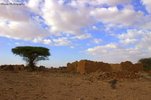mohammdov
Nabadshe
There are many destroyed cities from Sanaag to Awdal like Awbube,fardowsa,Maduuna,camuud
Despite this, no one knows the reason for its destruction, oral history only says that it was invaded But from who
Were they Oromo, Abyssinians, or some Somali Nomads?
Do you have sources that talk about this period?



Despite this, no one knows the reason for its destruction, oral history only says that it was invaded But from who
Were they Oromo, Abyssinians, or some Somali Nomads?
Do you have sources that talk about this period?


